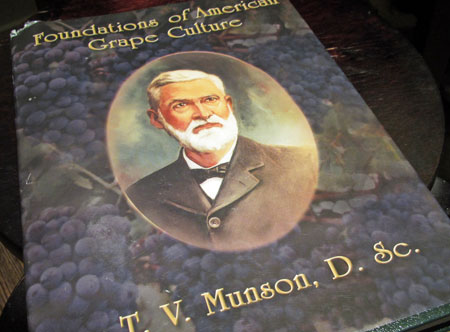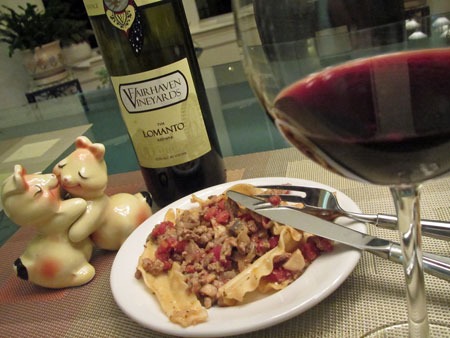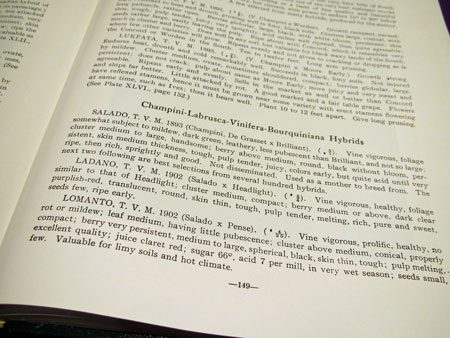Fairhaven Vineyards TVM 2009 Lomanto: Texas Bred, Texas Savored
It was truly one of the most incredible wine tastings…in Denison, Texas, at Vinita, the familial home of Thomas Volnay (T.V.) Munson. We had a host of wines, but not a name among them was recognizable from any of my previous wine tastings. The names included Lomanto, Ben Hur, Delicatessen, Wine King, and Nitodal. These are now only memories to me, except one.
R.L. Winters provided the wines made from grapes originally bred at the hand of the “Originator”, T.V. Munson: the grape breeder par excellence, horticulturalist, scientist, businessman, back roads traveler and savior of the French wine industry with Texas native root stock that gave him the moniker: The Grape Man of Texas.
R.L. is a master horticulturalist at his Fairhaven Vineyards, which has a mission to produce exceptional, fine quality French American and American Hybrid wines for sale in the Texas market and nationwide. He has begun a pioneering effort to develop his “Heritage Series” of super-hybrid wine grapes. The genetic base for this project was sourced from Fairhaven’s exceptionally rare American hybrid collection. His breeding vineyard is a living history of Texas wine Heritage. What heirlooms are to tomatoes, Munson varieties are to grapes.
In November of 2009, Fairhaven Lomanto became the first wine produced in R.L.’s Heritage Series.
All of the wines from my Vinita tasting were now history except for one, and it was a bottle of R.L.’s Fairhaven Vineyards 2009 Lomanto. The label on the bottle bares the initials TVM in honor of T.V. Munson’s great grape breeding work over a century ago.
Nearly immediately after I popped the cork on this baby, I knew that it had a lot to give. It was thick and dark with an opacity something like a California Zin. The color was a purple-blue-red, something that R.L. calls “astral purple with a stunning iridescent blue halo”. The aroma was still tight, but had readily discernible dark berries highlighted with mineral and mint notes. On the palate, it was pure black cherry: juicy, ripe and concentrated. After I sat awhile tasting this wine, I thought seriously if anyone had doubts that a red hybrid grape could go mainstream, they better think again.
The Fairhaven Lomanto was a deep, dark and serious red wine
According to R.L. “Regarding Lomanto, it’s one tough vine. We were able to get 400 of the vines through this last summer (a 100 year drought) without irrigation, and only had a few losses. In a normal year the vine shows very little damage from foliar fungal problems when a usual spray program is maintained.”
He continued, “Lomanto’s tolerance to Pierce’s Disease (PD) is exceptional. An occasional vine will show some symptoms but the problems usually occur on a single cordon (zonal) and rarely affect the entire vine. Berry size is 20-22mm and cluster weights will average about 14 ounces, with some ranging to 18.”
At more or less a pound a piece, those are what I call clusters.
R.L. gave me more details on the 2009 Lomanto harvest and how it was handled in his winery. He said, “In 2009, ripening was progressive and uniform. Harvest details and berry chemisty was as follows: Harvest 2009 July 14 at 6:45 am, Brix 21. pH 3.3. TA 0.90 g/l. Fermentation was in two stages: Primary fermentation with Lalvin ICV D254 and a secondary malolactic fermentation using Scott Labs Alpha ML. After that, the barrel treatment was new American oak all the way with 145 days in oak, a mere five months.
During my tasting, I decided that the Fairhaven Lomanto was a perfect match for tomato pasta with its fruit forward characteristics and moderate tannic structure. It was like having an “East Texas Montepulciano”, the red Italian wine grape variety acknowledged far and wide as having wine characteristics with a high pasta compatibility factor.
R.L. was specific about why it should be grown here in Texas: resistance to Pierce’s Disease and drought, while providing a good crop load, as well. But, why is Lomanto so good as a wine grape. I looked for an historical perspective by going back to T.V. Munsons words that I found in his seminal grape growing primer, Foundations of American Grape Culture.
Lomanto was a Munson hybrid grape that he produced in 1902 by crossing Salado and Pense grapes. Pardon if these are not household names, but from Munson’s notes these two grapes brought to Lomanto excellent quality claret red juice, good acidity and value for grower needing a grape for Texas’s limy soils and hot climate.
Furthermore, Lomanto was a cross that linked American and European grape cultures and over a hundred years later appears ready to serve and be served. In the cross, Munson used Salado, another Munson hybrid from 1893 that brought together Champini, De Grasset and Brillant, that he combined with Pense (also known as Malaga) that Munson realized was a European vinifera grape. Malaga has also be referred to by other names: Chevrier, Columbier and Blanc Doux. However, Malaga (Pense) is more commonly known these days as Semillon, the first-class sweet white grape of the French Sauternes. The ability of Malaga (Semillon) to produce ripe sweet juice appears to have come through in Lomanto, too.
For more on the Munson story and my “in the vineyard” tasting of Munson grapes, go to: http://www.wineslinger.net/?p=96





I am interested in lomanto grape vines.
Thank you,
Jerry
If you are interested in Lomanto, you need to talk to the world’s present expert in growing it. It’s R.L. Winters at Fairhaven Vineyards in Hawkings, TX. See website at:
http://www.fairhavenvineyards.com
Cheers,
Russ